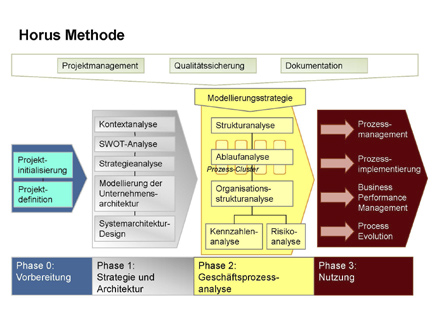Details
The Horus Method is a method for business process engineering and can be seen as a recipe which guides the user through different
defined steps of a modeling procedure. It is not a project procedure model like Scrum, but can be used additionally for the modeling tasks in a project. Also other aspects of a project procedure should be kept in mind like project management, quality assurance, and documentation. A graphical overview is provided in this PDF file.
The method makes heavy use of the abstraction and structuring principles and is structured in four phases: preparation phase, strategy and architecture phase, business process analysis phase and application phase. The preparation phase includes the initialization and definition of the project. The strategy and architecture phase emphasizes on strategic aspects and analysis of the enterprise and system architecture. The business process analysis phase is about modeling roles, objects, key figures, risks and processes. The application phase describes the usage of the created models, like the implementation and management of the processes. As the Horus Method emphasizes on the strategy and architecture phase as well as the business process analysis phasewe provide more details on those now.
Before the actual business process analysis is done the corporate strategy and architecture have to be analyzed. The reason is more a practical than a theoretical one,
because practical experience shows, that involving decision makers into a modeling project helps to increase the acceptance of the project. In phase 1 a context analysis is conducted to describe the environment, the aims and the supply & services model of the project. The next step is a SWOT analysis to address the strengths, weaknesses, opportunities and threats in the given context of the project. After the SWOT analysis the strategy analysis follows to identify strategies, risks and key figures to measure the corporate goals and strategy implementations. The strategy analysis is followed by the enterprise architecture model. The enterprise architecture model describes all the decision makers, who will detail the different enterprise processes. The core of the enterprise architecture is the business process architecture, linking business objects, business units and business rules together. If the modeling project aims at the development of an information system, phase 1 ends with the system architecture design, which is a high level representation of the system architecture. It will be detailed in phase 2. Phase 2 begins with a structure analysis. During structure analysis business objects and business rules, which span the business processes, are defined. Afterwards a procedure analysis is undertaken, resulting in one or more business process models, which are linked to the structural models. During organization structure analysis the organizational structure and the needed roles are defined. Competencies and responsibilities are established through links to the object and procedure models. Based on the organization and process structure a key figure analysis and risk analysis are conducted. All these tasks lead then to the actual application phase, in which processes are implemented, monitored and managed.


